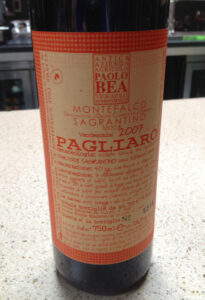2007 Paolo Bea, Montefalco Sagrantino “Pagliaro Secco” Umbria, Italy.
One of the great wines of the world and an icon of the natural wine movement, the Paolo Bea wines are an awesome collection of true terroir wines that led by the Pagliaro, the 100% Sagrantino di Montefalco red that tames this fiery tannic grape into a complex and age worthy wine. The earthy and leathery Pagliaro benefited greatly by the ripe 2007 vintage that brought out a wondrous array of dense red fruits, including currant, raspberry, plum and black cherry to go along with the dusty firm tannins as well as summer sage, dried lavender, fennel and cedary spice. This is majestic and raw in its transparency, this Pagliaro is one to covet and enjoy with robust foods that with cut into those tannins and allow the inner beauty to shine through, which will add to the awe this wine inspires, it is like if you married a Chave Hermitage with a Giacosa Barolo, it is a powerful wine that makes a dramatic impact on the full bodied palate. Air and swirling unlock both florals and savory elements in the bouquet, but this wine is not for overly polished and meek drinkers, it demands a lot of you for the best experience, as many world class bottles do. The 2007 Pagliaro is a wine that is reaching its potential about now, sadly I don’t have any in my cellar, which hurts when remembering just how good this wine was even upon release, it must certainly at this point be a riveting example of Sagrantino. For those keeping track, Montefalco first gained DOC status in 1979 as Montefalco DOC and Montefalco Sagrantino (or Sagrantino di Montefalco) was elevated to full DOCG status in 1992 after winemakers, like Arnaldo Caprai and Paolo Bea brought international fame and quality to this little known area.
The Bea family has called Montefalco, the rustically picturesque hill town in Umbria, home since the 1500s now has Paolo’s sons running the estate with Giampiero Bea making the wines, while Giuseppe focuses on the estate vineyards, which are organically farmed and includes mostly the native Sagrantino, along with some Montepulciano and the Umbrian version of Sangiovese as well as some local white grapes. The Pagliaro vineyard, situated perfectly to capture the warm sunshine at is close to 1300 feet above sea level, a point that allows a cooling influence at night to refresh the vines and giving the wine its depth and balance. The naturally fermented grapes for the Bea Pagliaro sees a long maceration, sometimes lasting close to two months, and then aged one full year in stainless steel vats before an elevage of two years in large Slavonian oak casks, again, similar to classic Barolo. This region has mixture of gravelly soils with limestone and clay playing a key role in the character of the wines, which show a slight stony and or chalky detail, especially in these Bea wines. Sagrantino was once a problem for the ancient wine growers and was tricky for them to craft dry wines as the legendary tannins required attention to detail and wine making techniques that were only developed in the last 60 years or so, which is why it was primarily used for passito late harvest sweet wines, with the Bea’s still making one, until more recent times. I have enjoyed many meals with Sagrantino di Montefalco, and I recommend rosemary crusted lamb or hard sleep cheeses as pairings that best serve this grape. This winery is a must for Italian wine lovers, especially this all Sagrantino Pagliaro, but also look for the Rosso de Veo, Pipparello and the basic Rosso IGT, which a tremendous value.
($90 Est.) 95 Points, grapelive
